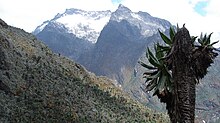
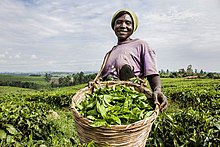

The effects of climate change in Uganda are increasingly severe, affecting the lives of the country's citizens and its environment. It has led to extreme weather events such as unpredictable, prolonged drought and rainfall. Uganda's climate is mostly tropical with regular rainfall and sunshine patterns. Due to climate change the seasons have changed, with the rainy season becoming more variable in length and droughts more ubiquitous, especially in eastern and northeastern Uganda. Climate trends have the potential to affect development of Uganda, due to the vulnerability of Uganda's diverse environment.
Greenhouse gas emissions
Uganda's greenhouse gas emission rate is very low, with carbon dioxide having never exceeding 150 kg per person per year, and totalling about 5 million tonnes per year. As of 2022, over 90% of Uganda's electricity comes from hydroelectricity, but many rural areas lack electricity and burn wood for cooking. The government has been criticized for causing deforestation.
Impact on the natural environment
Temperature and weather changes
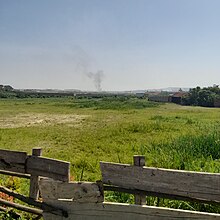
Since the 1960s, the average temperature in Uganda has increased by 1.3 °C, minimum temperatures have increased by 0.5–1.2 °C, and maximum temperatures have increased by 0.6–0.9 °C. Average temperatures have been observed to be increasing at a rate of 0.28 °C per decade, and daily temperature observations show significantly increasing amounts of hot days and nights every year . Climate change and changes in temperature is also affecting the Rwenzori Mountains, by causing glacier melting, increasing water levels in the Nyamwamba, Mubuku, and Ruimi Rivers. This has led to frequent flooding across the Rwenzori region. From 1906 to 2003, ice fields shrunk from 6.5 sq km to less than 1 sq km, and may completely melt in the next few years. In 2012, forest fires occurred in the Rwenzori region, causing the ice fields to melt, leading to the flooding of the river around the mountain.
In January 2022, intense rain around Mount Muhavura damaged buildings and roads in Kisoro District, especially affecting Nyarusiza, Muramba and Bunagana. Nine people were reported to have lost their lives and thousands of people were displaced or otherwise affected by this disaster.
On 1 March 2010, landslides occurred on the slopes of Mount Elgon, in the Bududa district, that killed 50 people and left thousands displaced. In 2018, there was another landslide on Mount Elgon, that killed 28 people, and left thousands displaced once again. As of 30 September 2021, a total of 20,739 people had been internally displaced. All landslides were caused by unusually prolonged rains.
 Köppen climate classification map for Uganda for 1980–2016
Köppen climate classification map for Uganda for 1980–2016 2071–2100 map under the most intense climate change scenario. Mid-range scenarios are currently considered more likely
2071–2100 map under the most intense climate change scenario. Mid-range scenarios are currently considered more likely
In Kasese District, there is flooding almost every year, which causes a heavy impact on the lives and livelihood of residents. As a result, many schools and homes are buried or destroyed, leaving many displaced.
On Saturday 30 July 2022 at around 8pm EAT in the evening, there was a down pour of rain that took several hours up to around 7am EAT in the morning of Sunday 31 July 2022 in Mbale district, Sebei region and part of

Teso region. This caused river Nabuyonga and river Namatala to burst the banks causing floods and landslides in Mbale district, Kapsinda Sub-county, Kapchorwa District. This led to a death toll of 24 in Mbale alone as of 2 August 2022, more bodies were recovered on that day. In Mbale, most of the affected areas were Mbale City, Nabuyonga, Nkoma and Namakwekwe in Northern City Division and Namatala in Industrial City Division.
Impact on water resources
Ugandan water supply and the sanitation sector has made substantial progress in urban areas from the mid-1990s until at least 2006, with substantial increases in coverage. Reforms from 1998 to 2003 included the commercialization and modernization of the National Water and Sewerage Corporation (NWSC) operating in cities and larger towns, as well as decentralization and private sector participation in small towns. Uganda has renewable water resources totalling to 2085 cubic meters per year, which is above the limit recognized internationally of 100 m/year of water scarcity. Nevertheless, the water sector is developed and only about 0.5% of the total available water is utilized per year.
| Sector | % |
|---|---|
| Agriculture | 40 |
| Municipal and industrial | 43 |
| Consumption | 17 |
Uganda has made some progress and improvements in water supply through improving facilities, increasing from 39% availability in 1990 to 48% in 2008, and, in remote and rural areas, from 40% in 1990 to 49% in 2008. This was not the case with the urban areas, which only increased from 35% in 1995 to 38% in 2008.
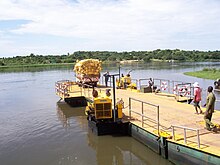
Ecosystems

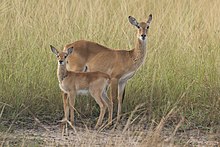 Wildlife in Ugandan ecosystems includes the African elephant and Ugandan kob
Wildlife in Ugandan ecosystems includes the African elephant and Ugandan kob
In 2010, Uganda had 6.93 Mha of tree cover, extending over 29% of its land area. In 2020, it lost 73.6 kha of tree cover, equivalent to 36.0 Mt of CO₂ emissions. From 2001 to 2020, 918 kha of tree cover was lost, equivalent to a 12% decrease in tree cover since 2000 and 413 Mt of CO₂ emissions. From 2001 to 2019, 3.8% of tree cover loss occurred in areas where dominant drivers resulted in deforestation. This has reduced both the ecosystem services the forests provide, including by diminishing wood yield and quality, and the biodiversity they support. 1.4 Mha of land has been burned, as of 2021. This total is normal, compared to the total for previous years, going back to 2001. The most fires recorded in a year was 2005, with 7.3 Mha burnt.
Impact on people
Economic impacts
Uganda's economy consists of three major sectors, agriculture, industry, and services, all of which are highly vulnerable to the effects of climate change. Climate change is affecting the agricultural sector by reducing the area suitable for agriculture due to population growth, altering the length of the growing season, reducing yield potential, increasing the frequency and severity of extreme events (in particular droughts and floods), and increasing the incidence of plant diseases.
Climate change damage estimates in the agriculture, water, infrastructure and energy sectors collectively amount to 2–4% of the GDP between 2010 and 2050. With an estimated population of 48,432,863, Uganda is the leading country of organic farming, with an estimate of 231,157 hectares of land used for farming.
Agriculture and livestock
Further information: Agriculture in UgandaClimate change has affected agriculture, which is the most important sector of the economy. Most of the production is from small scale farmers. Average temperatures range between 18 and 30 °C, but it can raise to about 37 °C in some areas.
Manufacturing sector
The Ugandan manufacturing sector is dominated by agro-processing, food and beverages, household products, construction materials and fast-moving consumer goods. Most firms are small and medium enterprises concentrated in Kampala and the Central Region. Most products manufactured in Uganda are aimed at domestic consumption, and exports are limited to the regional markets in East Africa, including Rwanda, Burundi, South Sudan, Democratic Republic of the Congo (DRC), and the regions of Kenya and Tanzania bordering Uganda.
Manufacturing was reported to account for 15.8% of GDP in 2020, according to the World Bank, employing about 6.622% of formal-sector labour.
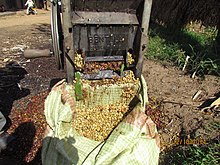

| Sector | Weight | 2016 | 2017 | 2018 | 2019 | 2020 | Pct. change 2018–2019 |
Pct. change 2019–2020 |
|---|---|---|---|---|---|---|---|---|
| Total manufacturing | 1000 | 234.67 | 245.29 | 268.34 | 277.69 | 285.91 | 3.5 | 3 |
| Food processing | 400 | 211.57 | 204.14 | 264.04 | 251.64 | 239.79 | -4.7 | -4.7 |
| Drinks and tobacco | 210 | 282.89 | 313.34 | 324.91 | 363.34 | 346.13 | 11.8 | -4.7 |
| Textiles, clothing and footwear | 43 | 153.37 | 166.97 | 170.48 | 204.08 | 252.78 | 19.7 | 23.9 |
| Sawmilling, paper and printing | 35 | 250.56 | 295.68 | 324.51 | 296.62 | 273.35 | -8.6 | -7.8 |
| Chemicals, paint, soap and foam products | 97 | 292.25 | 346.41 | 261.21 | 316.73 | 363.47 | 21.3 | 14.8 |
| Bricks and cement | 75 | 290.01 | 295.26 | 336.88 | 345.66 | 463.4 | 2.6 | 34.1 |
| Metal products | 83 | 162.94 | 168.53 | 154.13 | 149.5 | 162.78 | -3 | 8.2 |
| Miscellaneous | 66 | 214.24 | 202.25 | 230.61 | 238.02 | 248.84 | 3.2 | 4.5 |
| Ethiopia | Kenya | Vietnam | Uganda | |
|---|---|---|---|---|
| Industry contribution to GDP (%) | 27.3 | 16.4 | 34.2 | 19.9 |
| Share of manufactured exports to
total exports (%) |
13 | 28 | 83 | 23 |
| Manufacturing value added (%) | 5.8 | 7.7 | 16.0 | 8.3 |
| Share of employment (%) | 12 | 7.6 | 25.8 | 7.4 |
Health impacts
Climate change is increasing the occurrences of water-borne diseases such as dysentery, cholera, hepatitis E, vector-borne diseases, respiratory diseases, malnutrition-related illnesses, and especially malaria. Uganda's fourth Health Sector Development Plan indicates the importance of developing "early warning systems and dissemination of weather forecasts to help health managers to improve preparedness and response".
Mitigation and adaptations
A number of government agencies have been tasked with, or have prepared reports, on managing climate resilience, including the National Environmental Management Authority (NEMA), the Ministry of Water and Environment's Climate Change Department, the National Forestry Authority, the Ministry of Lands, Housing & Urban Development, the Ministry of Works and Transport, and the Uganda Wildlife Authority.
See also
References
- ^ "Climate Change Profile: Uganda – Uganda". ReliefWeb. Archived from the original on 17 April 2022. Retrieved 17 April 2022.
- "The impacts of climate change in Uganda – Uganda". ReliefWeb. Archived from the original on 17 April 2022. Retrieved 17 April 2022.
- Kibandama, Alexander (2019). "Climate Change Law in Uganda". Carbon & Climate Law Review. 13 (4): 246–256. doi:10.21552/cclr/2019/4/5. JSTOR 26895681. S2CID 213762198. Archived from the original on 12 May 2022. Retrieved 12 May 2022.
- Ritchie, Hannah; Roser, Max; Rosado, Pablo (11 May 2020). "CO₂ and Greenhouse Gas Emissions". Our World in Data. Archived from the original on 14 June 2021. Retrieved 20 April 2022.
- "Energy Generated to the National Grid". Electricity Regulatory Authority. Archived from the original on 8 June 2022. Retrieved 17 April 2022.
- Uganda, Joey Tyson in Mukono (29 June 2020). "Cooking up a solution to Uganda's deforestation crisis with mud stoves". the Guardian. Archived from the original on 21 April 2022. Retrieved 20 April 2022.
- "Uganda's silence at COP26 over growing deforestation". {$plugin.tx_news.opengraph.site_name}. Retrieved 20 April 2022.
- "World Bank Climate Change Knowledge Portal". climateknowledgeportal.worldbank.org. Archived from the original on 8 September 2021. Retrieved 17 April 2022.
- ^ "Uganda climate change: The people under threat from a melting glacier". BBC News. 29 March 2021. Archived from the original on 22 April 2022. Retrieved 18 April 2022.
- "Uganda – At Least 9 Killed in Western Region Flash Floods – FloodList". floodlist.com. Archived from the original on 30 January 2022. Retrieved 18 April 2022.
- Kamusiime, Micah (25 January 2022). "SAD! 8 people Killed in Kisoro District Flash floods". The Informer UG. Archived from the original on 21 June 2022. Retrieved 18 April 2022.
- "Eight deaths recorded in Uganda due to floods – Prensa Latina". 26 January 2022. Archived from the original on 21 June 2022. Retrieved 18 April 2022.
- "Uganda RedCross supports Kisoro flood victims". PML Daily. 27 January 2022. Archived from the original on 27 January 2022. Retrieved 18 April 2022.
- Foundation, Thomson Reuters. "After a deadly landslide in climate-hit Uganda, survivors sue". news.trust.org. Archived from the original on 3 May 2022. Retrieved 25 April 2022.
{{cite web}}:|first=has generic name (help) - "Uganda – Floods, landslides and hailstorms (DG ECHO, Uganda Red Cross Society, IOM, Office of the Prime Minister) (ECHO Daily Flash of 18 October 2021) – Uganda". ReliefWeb. Archived from the original on 25 April 2022. Retrieved 25 April 2022.
- "300 feared dead in Uganda". News24. 2 March 2010. Archived from the original on 5 March 2010. Retrieved 2 March 2010.
- Hausfather, Zeke; Peters, Glen (29 January 2020). "Emissions – the 'business as usual' story is misleading". Nature. 577 (7792): 618–20. Bibcode:2020Natur.577..618H. doi:10.1038/d41586-020-00177-3. PMID 31996825.
- Schuur, Edward A.G.; Abbott, Benjamin W.; Commane, Roisin; Ernakovich, Jessica; Euskirchen, Eugenie; Hugelius, Gustaf; Grosse, Guido; Jones, Miriam; Koven, Charlie; Leshyk, Victor; Lawrence, David; Loranty, Michael M.; Mauritz, Marguerite; Olefeldt, David; Natali, Susan; Rodenhizer, Heidi; Salmon, Verity; Schädel, Christina; Strauss, Jens; Treat, Claire; Turetsky, Merritt (2022). "Permafrost and Climate Change: Carbon Cycle Feedbacks From the Warming Arctic". Annual Review of Environment and Resources. 47: 343–371. doi:10.1146/annurev-environ-012220-011847.
Medium-range estimates of Arctic carbon emissions could result from moderate climate emission mitigation policies that keep global warming below 3°C (e.g., RCP4.5). This global warming level most closely matches country emissions reduction pledges made for the Paris Climate Agreement...
- Phiddian, Ellen (5 April 2022). "Explainer: IPCC Scenarios". Cosmos. Archived from the original on 20 September 2023. Retrieved 30 September 2023.
"The IPCC doesn't make projections about which of these scenarios is more likely, but other researchers and modellers can. The Australian Academy of Science, for instance, released a report last year stating that our current emissions trajectory had us headed for a 3°C warmer world, roughly in line with the middle scenario. Climate Action Tracker predicts 2.5 to 2.9°C of warming based on current policies and action, with pledges and government agreements taking this to 2.1°C.
- "Helping Kasese rise above the floods". www.unicef.org. Archived from the original on 18 April 2022. Retrieved 18 April 2022.
- Dr Paddy Musana, Bangirana Narcisio (August 2011). "Water, Crisis and Climate Change in Uganda: A Policy Brief" (PDF). IfP-EW Cluster: Climate Change and Conflict. Archived (PDF) from the original on 21 June 2022. Retrieved 17 April 2022.
- Independent, The (31 July 2022). "Rains cut off Mbale City temporarily". The Independent Uganda. Retrieved 2 August 2022.
- Kirabo, Jonah (1 August 2022). "Mbale floods death toll rises to 24 as 10 bodies are recovered from sunk car". Nile Post. Retrieved 2 August 2022.
- "Floods, landslides kill over 10 people in Eastern Uganda". Monitor. 1 August 2022. Retrieved 2 August 2022.
- "National water development report: Uganda". Unesco. 2006. Archived from the original on 20 January 2022. Retrieved 18 April 2022.
- ^ Dr Paddy Musana and Bangirana Narcisio, Peace and Conflict Studies MA Programme, Makerere University (August 2011). "Water, Crisis and Climate Change in Uganda: A Policy Brief" (PDF). Archived (PDF) from the original on 21 June 2022. Retrieved 17 April 2022.
{{cite journal}}: Cite journal requires|journal=(help)CS1 maint: multiple names: authors list (link) - ^ Vizzuality. "Uganda Deforestation Rates & Statistics | GFW". www.globalforestwatch.org. Archived from the original on 12 July 2017. Retrieved 18 April 2022.
- ^ Nick Dale and Anil Markandya of Metroeconomica, Dr Bernard Bashaasha of Makerere University, Olivier Beucher (Baastel) (March 2015). "Economic Assessment of the Impacts of Climate Change in Uganda". Ministry of Water and Environment Climate Change Department. Archived from the original on 21 June 2022. Retrieved 18 April 2022.
- "Top African Countries For Organic Farming". WorldAtlas. 5 July 2018. Archived from the original on 18 April 2022. Retrieved 18 April 2022.
- PricewaterhouseCoopers. "Agriculture". PwC. Archived from the original on 14 May 2022. Retrieved 18 April 2022.
- "What you can grow this planting season". Monitor. 26 February 2021. Archived from the original on 23 April 2021. Retrieved 18 April 2022.
- Vignesh Sridharan Eunice Pereira Ramos , Eduardo Zepeda , Brent Boehlert, Abhishek Shivakumar ,Constantinos Taliotis and Mark Howells (29 August 2019). "The Impact of Climate Change on Crop Production in Uganda—An Integrated Systems Assessment with Water and Energy Implications" (PDF). Archived (PDF) from the original on 16 June 2022. Retrieved 18 April 2022.
{{cite journal}}: Cite journal requires|journal=(help)CS1 maint: multiple names: authors list (link) - ^ Linda Calabrese, Frederick Golooba-Mutebi, Maximiliano Mendez-Parra (December 2019). "INDUSTRIAL DEVELOPMENT IN UGANDA "An assessment of the policy framework"" (PDF). Archived (PDF) from the original on 21 June 2021. Retrieved 18 April 2022.
{{cite journal}}: Cite journal requires|journal=(help) - ^ Uganda Investment Authority (26 January 2022). "Uganda's industrial journey so far: progress, achievements, and prospects". Uganda Investment Authority. Archived from the original on 29 January 2022. Retrieved 18 April 2022.
- Prof. John B. Kaddu (PhD), Berhane Gebru, Patrick Kibaya and Dr. Munabi Ian G (April 2020). "Climate Change and Health in Sub-Saharan Africa: The Case of Uganda" (PDF). Archived (PDF) from the original on 19 January 2022. Retrieved 18 April 2022.
{{cite journal}}: Cite journal requires|journal=(help)CS1 maint: multiple names: authors list (link) - "National Environment Management Authority". www.nema.go.ug. Archived from the original on 19 June 2022. Retrieved 18 April 2022.
- "Ministry of Water and Environment". www.mwe.go.ug. Archived from the original on 14 June 2022. Retrieved 18 April 2022.
- "Uganda: Climate Change – Govt Makes Case to Enhance Country's Tree Cover". allAfrica. 23 May 2022. Archived from the original on 21 June 2022. Retrieved 21 June 2022.
- Ministry of Lands, Housing & Urban Development. Ministry of Lands, Housing & Urban Development (Technical report). Archived from the original on 10 March 2017. Retrieved 21 June 2022.
- Assessment of climate change mitigation potentials and actions in Uganda’s transport sector (PDF) (Technical report). April 2022. Archived (PDF) from the original on 21 June 2022. Retrieved 21 June 2022.
- Climate Risks To Conservation In Uganda (PDF) (Technical report). Archived (PDF) from the original on 2 March 2022. Retrieved 21 June 2022.
| Climate change by country | |
|---|---|
| Greenhouse gas emissions, impacts, mitigation and adaptation in each country | |
| Africa | |
| Americas | |
| Asia | |
| Europe | |
| Oceania | |
| Polar regions | |
| Other regions | |